
USS Galena was a wooden-hulled broadside ironclad built for the United States Navy during the American Civil War. The ship was initially assigned to the North Atlantic Blockading Squadron and supported Union forces during the Peninsula Campaign in 1862. She was damaged during the Battle of Drewry's Bluff because her armor was too thin to prevent Confederate shots from penetrating. Widely regarded as a failure, Galena was reconstructed without most of her armor in 1863 and transferred to the West Gulf Blockading Squadron in 1864. The ship participated in the Battle of Mobile Bay and the subsequent Siege of Fort Morgan in August. She was briefly transferred to the East Gulf Blockading Squadron in September before she was sent to Philadelphia, Pennsylvania for repairs in November.

USS Onondaga was an ironclad monitor built for the Union Navy during the American Civil War. Commissioned in 1864, the ship spent her entire active career with the James River Flotilla covering the water approaches to the Confederate States capital of Richmond, Virginia, although her only notable engagement was the Battle of Trent's Reach. After the war, she was purchased by France where she served as a coastal defense ship in the French Navy.
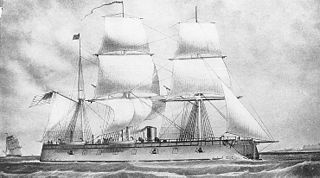
USS New Ironsides was a wooden-hulled broadside ironclad built for the United States Navy during the American Civil War. The ship spent most of her career blockading the Confederate ports of Charleston, South Carolina, and Wilmington, North Carolina, in 1863–65. New Ironsides bombarded the fortifications defending Charleston in 1863 during the First and Second Battles of Charleston Harbor. At the end of 1864 and the beginning of 1865 she bombarded the defenses of Wilmington in the First and Second Battles of Fort Fisher.
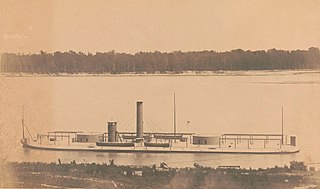
USS Chickasaw was an ironclad Milwaukee-class river monitor built for the United States Navy during the American Civil War. The ship participated in the Battle of Mobile Bay in August 1864, during which she was lightly damaged, and the bombardments of Forts Gaines and Morgan as Union troops besieged the fortifications defending the bay. In March–April 1865, Chickasaw again supported Union forces during the Mobile Campaign as they attacked Confederate fortifications defending the city of Mobile, Alabama.

USS Tecumseh was a Canonicus-class monitor built for the United States Navy during the American Civil War. Although intended for forthcoming operations against Confederate fortifications guarding Mobile Bay with Rear Admiral David Farragut's West Gulf Blockading Squadron, Tecumseh was temporarily assigned to the James River Flotilla in April 1864. The ship helped to plant obstacles in the river and engaged Confederate artillery batteries in June.
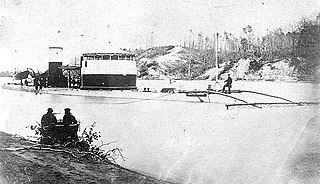
USS Saugus was a single-turreted Canonicus-class monitor built for the Union Navy during the American Civil War. The vessel was assigned to the James River Flotilla of the North Atlantic Blockading Squadron upon completion in April 1864. The ship spent most of her time stationed up the James River where she could support operations against Richmond and defend against a sortie by the Confederate ironclads of the James River Squadron. She engaged Confederate artillery batteries during the year and later participated in both attacks on Fort Fisher, defending the approaches to Wilmington, North Carolina, in December 1864 – January 1865. Saugus returned to the James River after the capture of Fort Fisher and remained there until Richmond, Virginia, was occupied in early April.
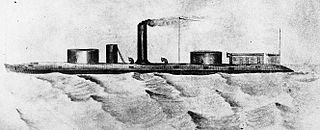
USS Winnebago was a double-turret Milwaukee-class river monitor, named for the Winnebago tribe of Siouan Indians, built for the Union Navy during the American Civil War. The ship participated in the Battle of Mobile Bay in 1864, during which she was lightly damaged, and the bombardments of Forts Gaines and Morgan as Union troops besieged the fortifications defending the bay. In early 1865, Winnebago again supported Union forces during the Mobile Campaign as they attacked Confederate fortifications defending the city of Mobile, Alabama. She was placed in reserve after the end of the war and sold in 1874.
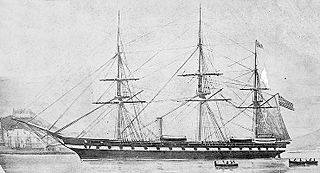
USS Roanoke was a wooden-hulled Merrimack-class screw frigate built for the United States Navy in the mid-1850s. She served as flagship of the Home Squadron in the late 1850s and captured several Confederate ships after the start of the American Civil War in 1861. The ship was converted into an ironclad monitor during 1862–63; the first ship with more than two gun turrets in history. Her conversion was not very successful as she rolled excessively and the weight of her armor and turrets strained her hull. Her deep draft meant that she could not operate off shallow Confederate ports and she was relegated to harbor defense at Hampton Roads, Virginia for the duration of the war. Roanoke was placed in reserve after the war and sold for scrap in 1883.

USS Neosho, the lead ship of her class, was an ironclad river monitor laid down for the Union Navy in the summer of 1862 during the American Civil War. After completion in mid-1863, the ship spent time patrolling the Mississippi River against Confederate raids and ambushes as part of Rear Admiral David Porter's Mississippi Squadron. She participated in the Red River Campaign in March–May 1864. Neosho resumed her patrols on the Mississippi after the end of the campaign. She supported the Union Army's operations on the Cumberland River and provided fire support during the Battle of Nashville in December 1864. Neosho was decommissioned after the war and remained in reserve until sold in 1873.

USS Osage was a single-turreted Neosho-class monitor built for the Union Navy during the American Civil War. After completion in mid-1863 by Edward Hartt, the ship patrolled the Mississippi River against Confederate raids and ambushes as part of Rear Admiral David Porter's Mississippi Squadron. Osage participated in the Red River Campaign in March–May 1864, during which she supported the capture of Fort DeRussy in March and participated in the Battle of Blair's Landing in April. The ship was grounded on a sandbar for six months after the end of the campaign and badly damaged. Osage, after being refloated and repaired, was transferred to the West Gulf Blockading Squadron in early 1865 for the campaign against Mobile, Alabama. During the Battle of Spanish Fort in March 1865 she struck a mine and rapidly sank. The ship was later salvaged and sold in 1867.
USS Kickapoo was a double-turreted Milwaukee-class river monitor, the lead ship of her class, built for the Union Navy during the American Civil War. The ship supported Union forces during the Mobile Campaign as they attacked Confederate fortifications defending the city of Mobile, Alabama in early 1865. She was placed in reserve after the end of the war and sold in 1874.
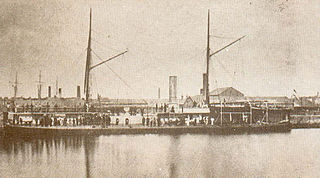
USS Oneota was a single-turreted Canonicus-class monitor built for the Union Navy during the American Civil War. Completed shortly after the end of the war, Oneota was laid up until sold to her builders in 1868, and then resold to the Peruvian Navy. Renamed BAP Manco Cápac, the ship participated in the defense of Arica during the War of the Pacific. When the town was taken by Chilean troops in 1880, she was scuttled to prevent her capture. Her wreck was rediscovered in 1960 and it has been heavily looted.
The first USS Milwaukee, a double-turreted Milwaukee-class river monitor, the lead ship of her class, built for the Union Navy during the American Civil War. The ship supported Union forces during the Mobile Campaign as they attacked Confederate fortifications defending the city of Mobile, Alabama in early 1865. She struck a mine in March and sank without loss. Her wreck was raised in 1868 and broken up for scrap that was used in the construction of a bridge in St. Louis, Missouri.
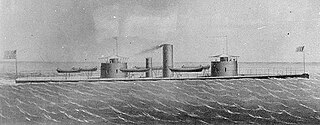
USS Monadnock was one of four Miantonomoh-class monitors built for the United States Navy during the American Civil War. Commissioned in late 1864, she participated in the First in December and Second Battles of Fort Fisher in January 1865. The ship was later assigned to the James River Flotilla on the approaches to the Confederate capitol of Richmond, Virginia and then sailed to Spanish Cuba to intercept the Confederate ironclad CSS Stonewall.
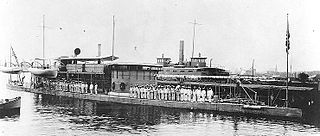
Originally named USS Tippecanoe, after the river in Indiana, USS Wyandotte was a single-turreted Canonicus-class monitor built for the Union Navy during the American Civil War. Completed after the end of the war, Wyandotte was laid up until 1876, although she received her new name in 1869. The ship was commissioned in 1876 and assigned to the North Atlantic Squadron for the next three years. She became a receiving ship in 1879 until she was placed in reserve again in 1885. Wyandotte was on militia duty when the Spanish–American War began and she was recommissioned in 1898 to defend Boston, Massachusetts from any Spanish raiders. The ship was decommissioned after the end of the war and sold for scrap in 1899.
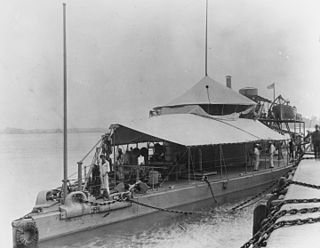
USS Ajax, originally named USS Manayunk after a town in Pennsylvania, was a single-turreted Canonicus-class monitor built for the Union Navy during the American Civil War. Completed after the end of the war, Ajax was laid up until 1871, although she received her new name in 1869. The ship was briefly activated in 1871, before a much longer commission began in 1874–1875. She was assigned to the North Atlantic Squadron during this time. Ajax was again placed in reserve in 1891. The ship was on militia duty when the Spanish–American War began and she was recommissioned in 1898, to defend Baltimore, Maryland, although she was decommissioned later in the year before the necessary refit could be completed. Ajax was sold for scrap in 1899.

USS Manhattan was a single-turreted Canonicus-class monitor built for the Union Navy during the American Civil War. After commissioning in 1864 the ship was assigned to the West Gulf Blockading Squadron and participated in the Battle of Mobile Bay. At the end of the battle, Manhattan took the surrender of the Confederate casemate ironclad ram Tennessee. She bombarded Fort Morgan during the Siege of Fort Morgan and later blockaded the mouth of the Red River until the end of the war.

USS Mahopac (1864) was a Canonicus-class monitor built for the Union Navy during the American Civil War. The vessel was assigned to the James River Flotilla of the North Atlantic Blockading Squadron upon completion in September 1864. The ship spent most of her time stationed up the James River where she could support operations against Richmond and defend against sorties by the Confederate ironclads of the James River Squadron. She engaged Confederate artillery batteries during the year and later participated in both the first and second battles of Fort Fisher, defending the approaches to Wilmington, North Carolina, in December 1864 – January 1865. Mahopac returned to the James River after the capture of Fort Fisher and remained there until Richmond, Virginia was occupied in early April.

The Neosho-class monitors were a pair of ironclad river monitors laid down in mid-1862 for the United States Navy during the American Civil War. After completion in mid-1863, both ships spent time patrolling the Mississippi River against Confederate raids and ambushes as part of Rear Admiral David Porter's Mississippi Squadron. Both ships participated in the Red River Campaign in March–May 1864, although Osage supported the capture of Fort DeRussy in March and participated in the Battle of Blair's Landing in April. Osage was grounded on a sandbar for six months after the end of the campaign while Neosho resumed her patrols on the Mississippi. The latter ship supported the Union Army's operations on the Cumberland River and provided fire support during the Battle of Nashville in December.
The Milwaukee-class monitors were a class of four riverine ironclad monitors built during the American Civil War. Several supported Union forces along the Mississippi River in mid-1864 before participating in the Battle of Mobile Bay in August. Chickasaw and Winnebago bombarded Confederate coastal fortifications during the battle and during subsequent operations as well as engaging the ironclad Tennessee II. The other two ships arrived at Mobile Bay after the battle and all four supported the land attacks on Mobile in March–April 1865. Milwaukee struck a torpedo during this time and sank. The surviving three ships were sold in 1874; Chickasaw was converted into a ferry and survived until 1944 when she was scuttled. Her wreck was discovered in 2004.
















